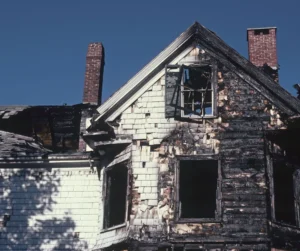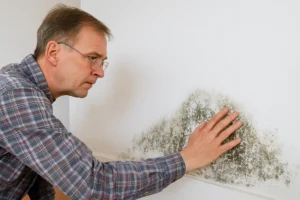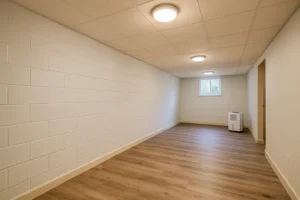Shut Off Your Water Supply Immediately
The very first action after a pipe bursts is to shut off your main water supply. This quick move can drastically limit water damage. Typically, you’ll find the shutoff valve near your water meter, in your basement, crawl space, or outside your home. Turning this valve clockwise will stop water flow immediately.
Locating and Using Your Main Water Shutoff Valve
The main shutoff valve is usually located by the water meter. It may be situated in your basement, crawl space, garage, or an outdoor utility area. In some cases, it might be near the property line or the street. The valve is usually a round or oval handle that you turn clockwise to close.
Turning Off the Water
To shut off the water, turn the valve handle clockwise until it stops. This will completely stop the flow of water into your home and prevent any further damage from the burst pipe.
If You Can't Find the Main Shutoff Valve
If you're unsure where your shutoff valve is located or if you cannot access it, you may need to contact your local water utility company or a professional plumber for assistance. We can help you locate the valve and shut off the water supply to your home.
4. Redirect Rainwater Away from Your Home
1. Ensure gutters and downspouts are directing water away from your foundation.
2. Avoid connecting downspouts or sump pumps directly to the sewer system, as this can cause overflows.
Drain Remaining Water from Your Pipes
After you have successfully shut off the main water supply and halted the flow of water, it’s crucial to release any residual water pressure within the plumbing system. This can be achieved by opening all the faucets in your house, both hot and cold, allowing the trapped water to drain out. This step is essential in minimizing the risk of additional leaks or bursts in the pipes.
Furthermore, don’t forget to flush all the toilets in your home multiple times. This action serves to eliminate the water remaining in the toilet tanks and bowls, as well as the water within the connected plumbing lines. By thoroughly draining the entire plumbing system, you’ll effectively reduce the strain on the pipes and decrease the likelihood of further damage.
Turn Off Electricity to Affected Areas
Water and electricity are a dangerous combination, and a burst pipe can quickly create a hazardous situation. If the water leak is anywhere near electrical outlets, appliances, or wiring, it's crucial to shut off the power to the affected area immediately. Locate your electrical breaker box and switch off the breaker that controls the area where the water leak is occurring.
Prioritizing Safety
Your safety is paramount. Avoid touching any wet electrical equipment, including outlets, switches, or appliances. If you are unsure about which breaker to switch off or have any concerns about the electrical system, it's best to err on the side of caution and call a qualified electrician to handle the situation. They have the expertise and equipment to safely navigate electrical issues in wet environments. Remember, attempting to fix electrical problems without proper knowledge can lead to serious injuries or even fatalities.
Document the Damage Thoroughly
Before starting cleanup, take detailed photos and videos of all affected areas and belongings. This documentation will be essential when filing insurance claims. Make sure to capture all angles and close-ups of damaged property to clearly show the extent of the issue.
For advice on documenting home insurance claims, visit this resource.
Begin Immediate Cleanup
Once you've documented the damage, start the cleanup immediately to prevent mold and structural damage. Mop up standing water, dry wet areas using towels, fans, or dehumidifiers, and remove any wet rugs, furniture, and belongings to a dry location.
Call a Professional Plumber
A burst pipe is typically not a DIY fix. A professional plumber can quickly identify the cause of the burst pipe, perform necessary repairs, and assess your plumbing system for other potential issues. Choosing a trusted plumber is critical to avoiding future complications.
If you don't yet have a trusted plumber, contact us.
Contact Your Home Insurance Provider
Notify your insurance company as soon as possible to start the claims process. Provide them with your documented evidence to expedite the claim. Your insurer will guide you through the next steps and inform you about coverage specifics related to water damage.
Prevent Mold and Mildew
Mold can start forming within 24-48 hours after water damage, causing potential health risks and further property damage. Use professional drying equipment, maintain proper ventilation, and consider hiring a mold remediation specialist to prevent or eliminate mold growth effectively.
Inspect and Restore Your Home
After emergency repairs and cleanup, it's important to thoroughly inspect your home for further water damage, hidden leaks, and structural integrity. Damaged walls, flooring, and ceilings might need professional restoration services
.
Hiring professional restoration experts ensures your home is safe, healthy, and structurally sound after a pipe burst.
Steps to Avoid Future Pipe Bursts
After resolving your immediate crisis, consider taking preventive steps to avoid future pipe bursts:
- Insulate exposed pipes
- Regularly check for leaks
- Maintain your home heating during cold weather
- Install a leak detection system
By proactively managing your home’s plumbing, you can significantly reduce the risk of another pipe emergency.
Take Immediate Action to Protect Your Home
Facing a burst pipe can be stressful, but knowing how to react quickly can mitigate the damage, expense, and inconvenience. Follow these crucial steps to safeguard your home and family.
Need Immediate Help? Contact Tradewind’s emergency plumbing services now—we’re here to protect your home!





